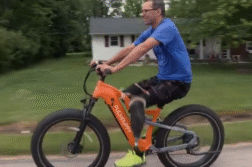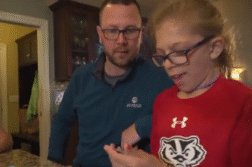CLEVELAND, Ohio (Ivanhoe Newswire)— Pancreatitis, a painful inflammation of the pancreas, is sometimes associated with older people. But there is another form of pancreatitis—one that is hereditary and impacts infants and children. There is no cure, and often, these kids are left enduring a lifetime of pain. Now, a new treatment is helping them live a happy, pain-free life, preventing diabetes.
Hera and Oscar, MoShoe the snake, Taco, the turtle and a chinchilla named Bubbles …
Lilah Ford’s pals kept her company when she was so sick, she couldn’t get out of bed.
“Like a sharp pain that would go from my stomach, like all the way to my back,” Lilah explained.
“Just every couple months it would hit and she’d be in constant pain for about a week,” shared Leah Ford, Lilah’s mom.
Born with hereditary pancreatitis, her dad knows first-hand the pain his daughter was dealing with.
“You couldn’t even imagine. Having experienced that, knowing that she’s got to live with that. Terrible,” stated Joe Ford.
Jordan Winter, MD, pancreatic surgeon, University Hospitals Rainbow Babies & Children’s removed Lilah’s gallbladder, spleen and most of her pancreas.
“If you take out the disease, the patient is often cured, which is really exciting,” said Dr. Winter.
But islet cells in the pancreas make insulin. Without one, diabetes is almost certain, almost, until now.
“What is really innovative as an option for patients with pancreatitis is the auto islet transfusion. We were able to give her islet cells, which make insulin, back to her,” continued Dr. Winter.
Lilah’s diseased pancreas was taken to a lab and the islet cells were removed.
“The next day we take Lilah back to the operating room and infuse those islet cells directly into her liver. In that case, her liver becomes her new endocrine organ or insulin producing organ,” explained Dr. Winter.
Lilah will need to check her insulin levels regularly, but so far so good.
“I don’t have this pain anymore,” smiled Lilah.
“Now she’s basically as normal as it’s gets again. It’s great to hear laughter,” shared Joe.
Doctors hope that in the future, researchers will not only be able to take islet cells from the existing pancreas, but also regenerate even more in the lab, giving patients an even greater chance at not becoming diabetic.
Contributors to this news report include: Marsha Lewis, Producer; Kirk Manson, Videographer; Roque Correa, Editor.
To receive a free weekly e-mail on medical breakthroughs from Ivanhoe, sign up at: http://www.ivanhoe.com/ftk
Source:
https://www.mayoclinic.org/diseases-conditions/pancreatitis/symptoms-causes/syc-20360227
MEDICAL BREAKTHROUGHS
RESEARCH SUMMARY
TOPIC: PREVENTING DIABETES: TRANSFUSION TRANSFORMING LIVES
REPORT: MB #4918
BACKGROUND: The pancreas is an organ in the upper abdomen that connects to the beginning of the small intestine and contains the pancreatic duct which drains digestive enzymes into the small intestine. The pancreas has two primary functions. It makes digestive enzymes and releases them into the small intestine to break down carbohydrates, proteins and fat from food. It also produces several hormones, like insulin, and releases them into the blood. Pancreatitis is an inflammation, or swelling, of the pancreas. When the pancreas is inflamed, the powerful digestive enzymes it makes can damage tissue. The inflamed pancreas can cause release of inflammatory cells and toxins that may harm your lungs, kidneys, and heart.
(Source: https://my.clevelandclinic.org/health/diseases/8103-pancreatitis)
DIAGNOSING: Signs and symptoms of hereditary pancreatitis usually begin in late childhood with an episode of acute pancreatitis. A sudden attack can cause abdominal pain, fever, nausea, or vomiting and typically lasts from one to three days, although some people may experience severe episodes that last longer. It can progress to recurrent acute pancreatitis with multiple episodes that recur over a period of at least a year. Recurrent acute pancreatitis leads to chronic pancreatitis, which occurs when the pancreas is persistently inflamed. This usually develops by early adulthood. Chronic pancreatitis includes occasional or frequent abdominal pain of varying severity, flatulence, and bloating. Many individuals with hereditary pancreatitis also develop abnormal calcium deposits in the pancreas known as pancreatic calcifications by early adulthood.
(Source: https://medlineplus.gov/genetics/condition/hereditary-pancreatitis/)
NEW THERAPY SHOWS PROMISE: Previous attempts at creating an animal model capable of mimicking human pancreatitis involved inserting smaller segments of human genes into mice, which resulted in low gene expression unable to cause the disease observed in humans. Researchers then tried a full-length version of the mutated human gene in hereditary pancreatitis. “Using a full-length gene can better resemble a human-like version of the condition in an animal model,” said Baoan Ji, MD, PhD, cancer biologist with Mayo Clinic. They were then able to assess potential mechanisms by which pancreatitis can develop. They realized the culprit was increased activity of trypsin, a digestive enzyme in the pancreas. Mice with induced pancreatitis were given an FDA-approved blood thinner, also known to have anti-trypsin effects, twice daily for a week. Research found the treatment was able to halt disease progression. Through further experiments, the team revealed that the anticoagulant properties of the drug were key.
(Source: https://discoverysedge.mayo.edu/2019/10/07/pancreatitis-new-therapy-shows-promise-in-mice/)
FOR MORE INFORMATION ON THIS REPORT, PLEASE CONTACT:
KATELYN MCCARTHY
KATELYN.MCCARTHY@UHHOSPITALS.ORG
If this story or any other Ivanhoe story has impacted your life or prompted you or someone you know to seek or change treatments, please let us know by contacting Marjorie Bekaert Thomas at mthomas@ivanhoe.com




